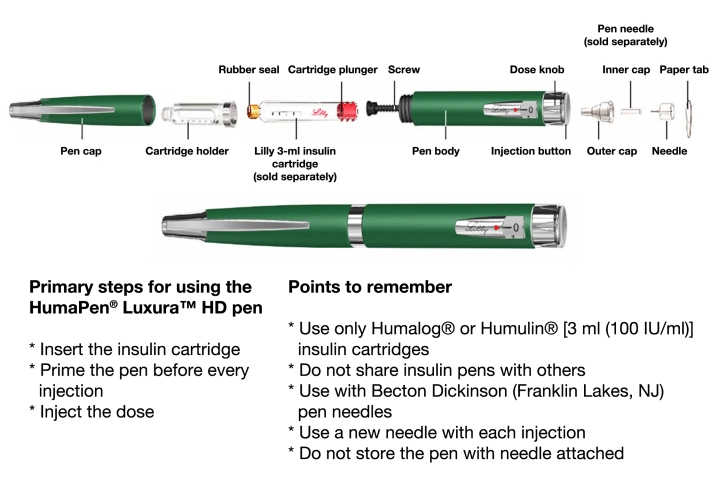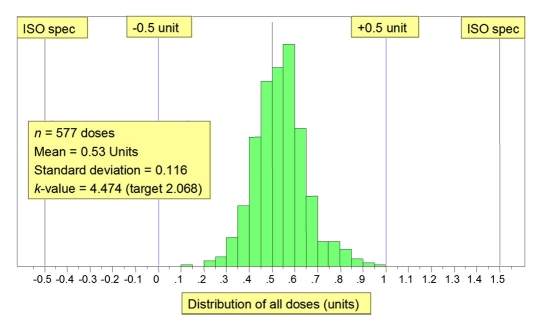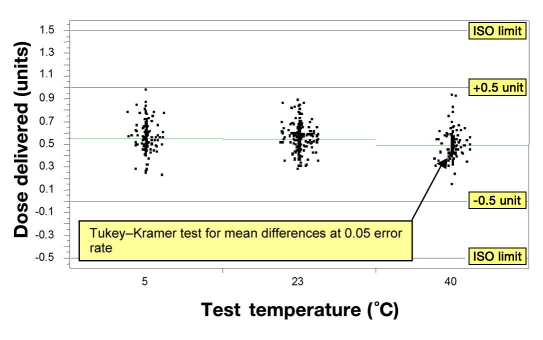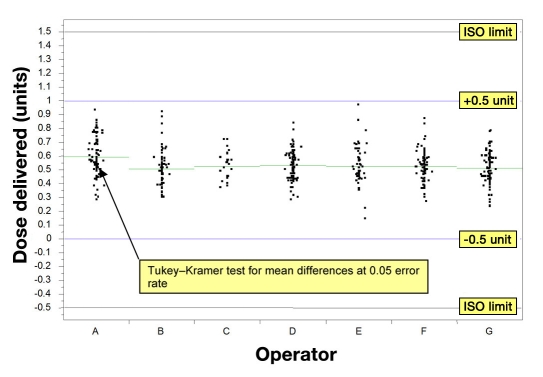Abstract
Background
The HumaPen® Luxura™ HD insulin pen (Eli Lilly and Company, Indianapolis, IN) was originally designed to deliver accurate doses in half-unit increments from 1 to 30 units. Laboratory testing examined the accuracy of the initial 0.5-unit dose within a 95/95% tolerance interval with respect to a specification of ±0.5 unit (±0.005 ml).
Methods
After priming, operators recorded the first 0.5 unit. Data were analyzed using k-value targets.
Results
While examining 577 half-unit doses per device lot, test temperature, operator, or test liquid, at least 95% of the doses were accurate with 95% confidence. All data points were within ±0.5 unit (±0.005 ml).
Conclusions
Dose accuracy of the initial half-unit is achieved with the HumaPen Luxura HD insulin pen.
Keywords: accuracy, diabetes, half-unit dose, HumaPen Luxura HD, insulin pen
Introduction
Children with type 1 diabetes most commonly receive their insulin using a pen device and insulin syringes.1 Although all insulin pens meet International Organization for Standardization (ISO) 11608-1:2000 standards2for dose accuracy at 1 unit, no pen device has been proven to be dose accurate at 0.5 unit. Half-unit dose accuracy may be particularly important in the type 1 pediatric population because studies have shown a positive correlation between the percentage of hypoglycemic events in children and the accuracy of a regular insulin dose.1
This study examines the accuracy of the initial half-unit dose setting of the HumaPen® Luxura™ HD insulin pen within a 95/95% tolerance interval with respect to a specification of ±0.5 unit (±0.005 ml). Insulin pens that have the function to administer precise half-unit doses of insulin offer new options to children with type 1 diabetes and to their caregivers who administer the insulin treatment.
Methods
Dose Accuracy Testing
Tests were performed to examine dose accuracy at the half-unit dose setting of the HumaPen Luxura HD insulin pen. This included 577 half-unit doses tested between July 2007 and October 2008. Because the HumaPen Luxura HD insulin pen did not have a printed mark at the initial half-dose, doses were identified by the audible/tactile click-stop present at this position on the dial. Operators attached a 31-gauge Becton Dickinson (Franklin Lakes, NJ) needle and primed the pen until a stream of fluid was visualized according to the product labeling/user manual.
An ISO 11608-1 compliant dose accuracy glide force (DAGF) system was used to record the delivered dose.2 The operator dials the required dose on the pen. The computer-controlled DAGF system injects that dose into a laboratory balance. The DAGF system calculates dose accuracy from the weight recorded by the balance. The testing documented in this report was designed to include several sources of variation:
five different HumaPen Luxura HD insulin pen lots
three different temperatures as specified in ISO 11608 [5°C, room temperature (RT), and 40°C]
seven different operators
three different types of Lilly insulin and three lots of saline cartridges
Statistical Methods
Data from the tests were combined and analyzed to determine the mean delivered dose and k value for the entire data set. These combined data were also analyzed by pen lot number, temperature, operator, and test liquid. Sample k values were calculated using half of the ISO 11608 tolerance ±0.5 unit (0.005 ml).3 Target k values were set for each analysis based on the sample size.
Using the HumaPen Luxura HD Insulin Pen
The primary steps to using the HumaPen Luxura HD insulin pen and points to remember are listed in Figure 1.
Figure 1.
Description of all pen parts of the HumaPen® Luxura™ HD insulin pen, steps for use, and points to remember.
Results
Data from all tests are plotted in Figure 2. The mean dose was 0.53 unit (0.00534 ml), and the entire data set k value was 4.474 (target 2.068). Data were grouped by device lot and analyzed (Figure 3). There was no statistical difference between means of doses per device lot. Pens from all lots had k values above target k values (Figure 3).
Figure 2.
Distribution of all doses. Spec, specification
Figure 3.
Analysis of dose by pen lot.
Data were grouped by test condition and are presented in Figure 4. The mean for the “hot” (40°C) temperature was statistically different than the “cool” (5°C) and the “standard” (RT) but not relevant. All k values exceeded target values.
Figure 4.
Analysis of dose by test temperature.
Data were grouped by operator (A–G) and are presented in Figure 5. All operators exceeded target k values even though the mean for operator A was statistically different than the other operators' mean doses.
Figure 5.
Analysis of dose by operator (A–G).
Data analyzed by cartridge lot are presented in Figure 6. All cartridge lots exceeded target k values. The insulin lispro protamine suspension (ILPS) [Humalog® Basal (Europe), Humalog® N (Japan)] lot was statistically significantly different than the other five as a group, and saline C was statistically significantly different than the other five as a group (Figure 6). This difference is not relevant.
Figure 6.
Analysis of dose by test liquid: insulin lispro (Humalog®), insulin lispro mix 25 (Humalog® Mix 75/25™), ILPS, and salines A, B, and C.
Discussion
The HumaPen Luxura HD is the first insulin pen to deliver accurate 0.5-unit doses of insulin lispro (Humalog®) or human insulin [recombinant DNA; Humulin®].4 Studies have shown that pen devices are preferred over the vial and syringe (V&S), and errors in dosing are reduced with insulin pens when compared to a V&S.4 Additionally, dosing can be inaccurate when using a V&S.5
Considering these advantages and the precise delivery of a half-unit dose, the HumaPen Luxura HD insulin pen may be beneficial to the type 1 diabetes population who require smaller doses of insulin.
Those using the HumaPen Luxura HD insulin pen must be aware that it is limited to use with a Lilly 3-ml insulin cartridge.6 When using the HumaPen Luxura HD pen, there is a high degree of confidence that 95% of the initial half-unit doses are achieved accurately when dosed across five different device lots, at three different temperatures, by seven different operators, and across six different cartridge lots (three saline and three insulin).
Conclusions
Dose accuracy at the 0.5-unit setting, identified by an audio click-stop, may provide confidence to patients with type 1 diabetes that they are administering the precise amount of insulin.
Acknowledgment
The authors are employees and shareholders of Eli Lilly and Company.
Abbreviations
- DAGF
dose accuracy glide force test system
- ILPS
insulin lispro protamine suspension
- ISO
International Organization for Standardization
- RT
room temperature
- V&S
vial and syringe
References
- 1.Lteif AN, Schwenk WF. Accuracy of pen injectors versus insulin syringes in children with type 1 diabetes. Diabetes Care. 1999;22(1):137–140. doi: 10.2337/diacare.22.1.137. [DOI] [PubMed] [Google Scholar]
- 2.International Organization for Standardization. ISO11608-1:2000 pen-injectors for medical use–Part 1: Pen injector requirements and test methods. Geneva: International Organization for Standardization; 2000. [Google Scholar]
- 3.Odeh RE, Owen DB. Tables for normal tolerance limits, sampling plans, and screening. New York: Marcel Dekker, Inc.; 1980. [Google Scholar]
- 4.Brunton S. Initiating insulin therapy in type 2 diabetes: benefits of insulin analogs and insulin pens. Diabetes Technol Ther. 2008;10(4):247–256. doi: 10.1089/dia.2008.0287. [DOI] [PubMed] [Google Scholar]
- 5.Pfützner A, Asakura T, Sommavilla B, Lee W. Insulin delivery with FlexPen: dose accuracy, patient preference and adherence. Expert Opin Drug Deliv. 2008;5(8):915–925. doi: 10.1517/17425247.5.8.915. [DOI] [PubMed] [Google Scholar]
- 6.Magnotti MA, Rayfield EJ. An update on insulin injection devices. Insulin. 2007;2(4):173–181. [Google Scholar]








